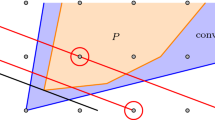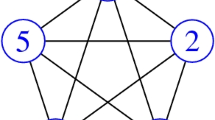Abstract
In this paper we provide characterizing properties of totally dual integral (TDI) systems, among others the following: a system of linear inequalities is TDI if and only if its coefficient vectors form a Hilbert basis, and there exists a test-set for the system’s dual integer programs where all test vectors have positive entries equal to 1. Reformulations of this provide relations between computational algebra and integer programming and they contain Applegate, Cook and McCormick’s sufficient condition for the TDI property and Sturmfels’ theorem relating toric initial ideals generated by square-free monomials to unimodular triangulations. We also study the theoretical and practical efficiency and limits of the characterizations of the TDI property presented here. In the particular case of set packing polyhedra our results correspond to endowing the weak perfect graph theorem with an additional, computationally interesting, geometric feature: the normal fan of the stable set polytope of a perfect graph can be refined into a regular triangulation consisting only of unimodular cones.
Similar content being viewed by others
References
Applegate D., Cook W., McCormick T.: Integral feasibility and testing total dual integrality. Oper. Res. Lett. 10, 37–41 (1991)
Barvinok A., Woods K.: Short rational generating functions for lattice point problems. J. Am. Math. Soc. 16, 957–979 (2003)
Bruns W., Gubeladze J., Henk M., Martin A., Weismantel R.: A counterexample to an integer analogue of Carathéodory theorem. J. Reine Angew. Math. 510, 179–185 (1999)
Chandrasekaran R., Tamir A.: On the integrality of an extreme solution to pluperfect graph and balanced systems. Oper. Res. Lett. 3, 215–218 (1984)
Conti, P., Traverso, C.: Buchberger algorithm and integer programming. In: Applied Algebra, Algebraic Algorithms and Error-Correcting Codes. Lecture Notes in Computer Science, vol. 539. Springer, Berlin (1991)
Cook W., Fonlupt J., Schrijver A.: An integer analogue of Carathéodory’s theorem. J. Comb. Theory (B) 40, 63–70 (1986)
Cook W., Lovász L., Schrijver A.: A polynomial-time test for total dual integrality in fixed dimension. Math. Progr. Study 22, 64–69 (1984)
Cornuéjols, G.: Combinatorial optimization: packing and covering. In: CBMS-NSF Regional Conference Series in Applied Mathematics, vol. 74. SIAM (2001)
Chudnovsky M., Cornuéjols G., Liu X., Seymour P., Vušković K.: Recognizing Berge graphs. Combinatorica 25(2), 143–186 (2005)
Chudnovsky M., Robertson N., Seymour P., Thomas R.: The strong perfect graph theorem. Ann. Math. 164(1), 51–229 (2006)
Cox D., Little J., O’Shea D.: Ideals, Varieties and Algorithms, 2nd edn. Springer-Verlag, New York (1996)
De Loera, J.A., Lee, J., Malkin, P., Margulies, S.: Hilbert’s Nullstellensatz and an algorithm for proving combinatorial infeasibility. In: ISSAC 21: Proceedings of the Twenty-First International Symposium on Symbolic and Algebraic Computation, pp. 197–206. ACM, New York (2008)
Ding G., Feng L., Zang W.: The complexity of recognizing linear systems with certain integrality properties. Math. Progr. 114, 321–334 (2008)
Dueck P., Hoşten S., Sturmfels B.: Normal Toric ideals of low codimension. J. Pure Appl. Algebra 213, 1636–1641 (2009)
Eisenbrand F., Shmonin G.: Parametric integer programming in fixed dimension. Math. Oper. Res. 33, 839–850 (2008)
Eisenbrand, F., Sebő, A., Shmonin, G.: Testing Hilbert bases. August 2007 (manuscript)
Fukuda, K.: cdd+ reference manual. Institute for Operations Research, Swiss Federal Institute of Technology, Zurich, Switzerland. http://www.ifor.math.ethz.ch/~fukuda/cdd_home/cdd.html (1995)
Fulkerson D.R.: Anti-blocking polyhedra. J. Comb. Theory (B) 12, 50–71 (1972)
Gawrilow, E., Joswig, M.: Polymake: a framework for analyzing convex polytopes. In: Polytopes—Combinatorics and Computation (Oberwolfach, 1997), pp. 43–73. DMV Sem. 29. Birkhäuser, Basel (2000)
Gerards A., Sebő A.: Total dual integrality implies local strong unimodularity. Math. Progr. 38, 69–73 (1987)
Golumbic M.C.: Algorithmic Graph Theory and Perfect Graphs. Academic Press, New York (1980)
Graver J.: On the foundations of linear and integer programming I. Math. Progr. 8, 207–226 (1975)
Grayson, D., Stillman, M.: Macaulay 2, a software system for research in algebraic geometry. http://www.math.uiuc.edu/Macaulay2/
Grötschel M., Lovász L., Schrijver A.: Geometric Algorithms and Combinatorial Optimization. Springer, Berlin (1984)
Hemmecke, R., Onn, S., Weismantel, R.: A polynomial oracle-time algorithm for convex integer minimization. Math. Progr. A. doi:10.1007/s10107-009-0276-7
Hoşten S., Sturmfels B.: Computing the integer programming gap. Combinatorica 27, 367–382 (2007)
Lee C.W.: Regular triangulations of convex polytopes. DIMACS Series Discrete Math. Theor. Comput. Sci. 4, 443–456 (1991)
Lenstra H.W. Jr.: Integer programming with a fixed number of variables. Math. Oper. Res. 8, 538–548 (1983)
Lovász L.: Normal hypergraphs and the perfect graph conjecture. Discrete Math. 2, 253–267 (1972)
Lueker, G.S.: Structured Breadth First Search and Chordal Graphs. Princeton Univ. Tech. Rep. TR-158
Mayr E.W., Meyer A.: The complexity of the word problems for commutative semigroups and polynomial ideals. Adv. Math. 46, 305–329 (1982)
Ohsugi H., Hibi T.: Convex polytopes all of whose reverse lexicographic initial ideals are squarefree. Proc. A.M.S. 129, 2541–2546 (2001)
O’Shea, E.: Toric algebra and the weak perfect graph theorem. Ph.D. dissertation, University of Washington (2006)
O’Shea, E., Sebő, A.: Characterizations of total dual integrality. In: Fischetti, M., Williamson, D. (eds.) Integer Programming and Combinatorial Optimization, vol. 12. LNCS (2007)
Padberg M.: Perfect zero-one matrices. Math. Progr. 6, 180–196 (1974)
Pap, J.: Recognizing conic TDI systems is hard. EGRES Technical Report TR-2008-15. Mathematical Programming. doi:10.1007/s10107-009-0294-5
Rambau, J.: TOPCOM (Triangulations of Point Configurations and Oriented Matroids). http://www.uni-bayreuth.de/departments/wirtschaftsmathematik/rambau/TOPCOM/
Rose, D.J., Tarjan, R.E.: Algorithmic aspects of vertex elimination. In: Proc. 7. Ann. ACM Symp., Theory Comput, pp. 245–254 (1975)
Saito, M., Sturmfels, B., Takayama, N.: Gröbner deformations of hypergeometric differential equations. In: Algorithms and Computation in Mathematics, vol. 6. Springer-Verlag, Berlin (2000)
Schrijver A.: Theory of Linear and Integer Programming. Wiley, New York (1986)
Sebő A.: Hilbert bases, Caratheodory’s theorem and combinatorial optimization. In: Kannan, R., Pulleyblank, W. (eds) Integer Programming and Combinatorial Optimization, Mathematical Programming Society, University of Waterloo Press, Waterloo (1990)
Sebő, A.: Problem A.6, “TDI Matrices”. In: Open Problems Workshop on “The Perfect Graph Conjecture”. http://www.aimath.org/pastworkshops/perfectgraph.html (2002)
Sturmfels B.: Gröbner bases of toric varieties. Tohoku Math. J. 43, 249–261 (1991)
Sturmfels B., Weismantel R., Ziegler G.M.: Gröbner bases of lattices, corner polyhedra, and integer programming. Beiträge Algebra Geom. 36, 281–298 (1995)
Sturmfels, B.: Gröbner bases and convex polytopes. University Lecture Series, vol. 8. American Mathematical Society, Providence (1996)
Sturmfels, B.: Algebraic recipes for integer programming. AMS Shortcourse: Trends in Optimization. In: Hoşten, S., Lee, J., Thomas, R.R. (eds.) Proceedings of Symposia in Applied Mathematics, vol. 61. American Mathematical Society, Providence (2004)
Sturmfels B., Thomas R.R.: Variations of cost functions in integer programming. Math. Progr. 77, 357–387 (1997)
Thomas R.R.: Algebraic methods in integer programming. In: Floudas, C., Pardalos, P. (eds) Encyclopedia of Optimization, Kluwer Academic Publishers, Dordrecht (2001)
Author information
Authors and Affiliations
Corresponding author
Additional information
E. O’Shea was supported by a Fulbright grant and by NSF grants DMS-9983797 and DMS-0401047. A. Sebö was supported by the “Marie Curie Training Network” ADONET of the European Community.
Rights and permissions
About this article
Cite this article
O’Shea, E., Sebö, A. Alternatives for testing total dual integrality. Math. Program. 132, 57–78 (2012). https://doi.org/10.1007/s10107-010-0383-5
Received:
Accepted:
Published:
Issue Date:
DOI: https://doi.org/10.1007/s10107-010-0383-5




